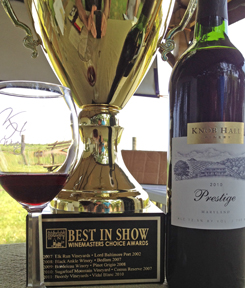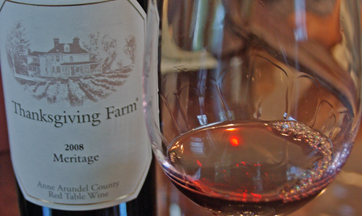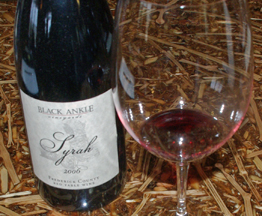Some Misconceptions About Maryland Wine
by
Terry Sullivan
As interest increases in the Drink Local Wine Conference coming to Maryland on April 13th, 2013, wine consumers and wine writers are beginning to look at Maryland as a wine producing state. Like many of the other states not on the west coast of the United States, some people have misconceptions about the wine produced in the state.
 Misconception #1: Maryland wine isn’t very good.
Misconception #1: Maryland wine isn’t very good.
I’ve heard this phrase uttered occasionally both by wine tourists as well as people in the wine media. It is not just Maryland that endures the brunt of this statement, it is also every state other than California, Oregon and Washington. A couple of years ago while in a Prosser, Washington winery, a wine tourist from the East said the wines in his state were not very good. More recently at the International Wine Tourism Conference in Zagreb, Croatia an American member of our media group said the wines from her east coast state were not very good. A day later, a California member of our media group blasted a wine conference for being held in an eastern state because the wines from that state are not very good. What is lacking by the tourist and media members is wine education.
When pressed to explain how all the wines from a particular state are faulted (not very good) we learned that the wines are not faulted. It is just a case that the individual making the statement didn’t like the wines. I believe there is a big distinction between the phrase “the wines are not very good” and the phrase “I don’t like the wines.” When one says they don’t like the wines, they are making a personal judgement. This is fine; however, just because someone doesn’t like the wines, doesn’t mean everyone doesn’t like the wines. The statement that the wines are not very good is an overgeneralization that condemns the wines in a region or state. Wine writers who make the statement are clearly going for the sensational at the expense of factual.
I was very impressed a year ago at the Drink Local Wine Conference in Denver, Colorado. One session was a blind tasting pitting Colorado wines against California wines. Each attendee had the opportunity to taste the wines and decide for themselves. There was a panel of sommeliers who attended and gave their opinions. All of the sommeliers were very guarded with the statements they made about the wines. No wines were bashed. If one was preferred over another they stated why they personally like one rather than the other. The sommeliers also preferred different wines and always had respect for each other’s preferences. When I mentioned this to a French sommelier while in Zagreb, she responded that sommeliers are taught not to bash wines. Sommeliers talk about wines from their personal point of view. Wine writers and wine travelers should take a lesson from sommeliers.
The next time you hear someone utter the phrase that the wines from X are not very good, ask them what faults all the wines have from X that make them not very good. See if you discover that the individual making the statement really means that he/she didn’t like the wines. As far as Maryland is concerned, the wines in this state are not faulted. Although some may not like them, others do enjoy them. The growth of the wine industry is a testament that many do enjoy the wines from Maryland.
Misconception #2: All Maryland wines are sweet.
This statement is simply not true. Visit a Maryland winery and taste their portfolio of wines. You will discover that there are many wines including dry wines. The four main grape varieties used to make wine at over two-thirds of Maryland wineries include Chardonnay, Cabernet Sauvignon, Cabernet Franc and Merlot. These grapes are most often used to make dry wines.
Many of the state’s wineries do make sweet wines. This is a matter of economics. Some people want sweet wines. If your business plan includes only making dry wines, you will not meet the needs of the sweet wine drinkers who will turn to another winery. This misconception is based on a lack of knowledge. Visit Maryland wineries and find out for yourself.
Misconception #3: Maryland makes mostly fruit wines.
 Like the last misconception this too is not true. There are Maryland wineries that make fruit wines. If you check out the portfolios of all Maryland wineries you’ll discover that most wines are made from wine grapes. Several years ago Kathy and I volunteered to pour wines for Fiore Winery at the Wines in the Woods wine festival in Columbia, Maryland. That festival drew several thousand people on both Saturday and Sunday. Sales of Fiore wines were good. By Sunday, just a couple hours after opening, Fiore sold out of it first wine it brought to the festival. It was a peach wine.
Like the last misconception this too is not true. There are Maryland wineries that make fruit wines. If you check out the portfolios of all Maryland wineries you’ll discover that most wines are made from wine grapes. Several years ago Kathy and I volunteered to pour wines for Fiore Winery at the Wines in the Woods wine festival in Columbia, Maryland. That festival drew several thousand people on both Saturday and Sunday. Sales of Fiore wines were good. By Sunday, just a couple hours after opening, Fiore sold out of it first wine it brought to the festival. It was a peach wine.
Making fruit wines is also a matter of economics. Many wineries have stainless steel tanks that are empty a few months of the year. Fruit wines can be made at any time of the year. In order to capitalize on empty tank space, some of these wineries make fruit wines. Fruit wines do not usually age, they are sold fresh. So there is a short period of time from fermentation to bottling to the retail shelf. It makes good economic sense to make fruit wine especially if you have a market for them.
Misconception #4: Maryland wines are expensive.
When compared to mass-produced wines that can be bought in grocery stores this concept bears some truth. Morris Zwick of Terrapin Station Winery points out that small wineries cannot compete price wise with Yellow Tail, a mass-marketed engineered wine. If consumers want to “taste the place” the wines are going to be more expensive not just in Maryland but also throughout the country. One can discover reasonably priced wines at many of the state’s wineries as well as more expensive wines.
Misconception #5 All Maryland wineries are making the same mediocre wine that was made decades ago.
 Old habits die hard. So do old ideas. One misconception is that Maryland wineries are making the same mediocre wine today as they made decades ago. This idea is also dealt with by wineries throughout the country and was pointed out by winemakers and owners at several Maryland wineries. Ken Korando of Solomons Island Winery commented that at one time when the state had few wineries there were some mediocre wines produced. However, Ken is quick to point out that new wineries in the state are “making some super wines.” Carl O. DiManno also commented that before tasting wines some visitors to Sugarloaf Mountain Vineyard thought Maryland wines were poor, not very complex and tasted like bell pepper. Anthony Aellen, president and winemaker at Berrywine Plantations, Inc Linganore Winecellars thinks that this perception is changing but will still take time. He cites the hundreds of medals that Maryland wines have won as testament that the quality of wine is not poor.
Old habits die hard. So do old ideas. One misconception is that Maryland wineries are making the same mediocre wine today as they made decades ago. This idea is also dealt with by wineries throughout the country and was pointed out by winemakers and owners at several Maryland wineries. Ken Korando of Solomons Island Winery commented that at one time when the state had few wineries there were some mediocre wines produced. However, Ken is quick to point out that new wineries in the state are “making some super wines.” Carl O. DiManno also commented that before tasting wines some visitors to Sugarloaf Mountain Vineyard thought Maryland wines were poor, not very complex and tasted like bell pepper. Anthony Aellen, president and winemaker at Berrywine Plantations, Inc Linganore Winecellars thinks that this perception is changing but will still take time. He cites the hundreds of medals that Maryland wines have won as testament that the quality of wine is not poor.
If visitors taste a wine and don’t like it, they may become quick to over generalize and say all the wine in the state is bad. If a visitor to a tasting room doesn’t like the wine, it doesn’t mean the wine is bad. It means the visitor doesn’t like the wine; others may enjoy it. Wineries need to educate their consumers about wine including wine faults so that wine tasters can differentiate between wines they do not like and wines that have something wrong with them.
The best way to learn about Maryland wine is to visit wineries in the state. Taste their portfolio and judge for yourself.
Article rewritten April 2013
If interested in Wine Trail Travelers coverage of conferences check the below links.
Drink Local Wine Conference coverage
International Wine Tourism Conference coverage
